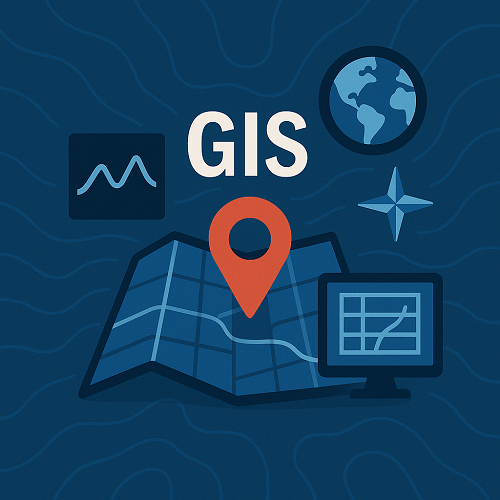TL;DR
- AI-driven GIS analytics are enabling real-time, high-accuracy mapping across industries.
- Integration of IoT sensors with GIS is creating dynamic, continuously updated spatial datasets.
- 3D GIS visualization is making urban planning and infrastructure projects more immersive and precise.
- Open geospatial data initiatives are expanding accessibility and collaboration opportunities.
- Blockchain-based GIS applications are enhancing data security and provenance tracking.
What’s New Right Now
In 2025, GIS technologies are evolving rapidly with transformative integrations. Artificial Intelligence (AI) is being paired with spatial analysis to automate pattern detection and predictive modelling (Esri ArcGIS overview). IoT devices are increasingly embedded in everything from autonomous vehicles to environmental monitoring stations, continuously feeding real-time location data to GIS platforms (IoT Analytics). The growth of 3D GIS is reshaping urban environments with detailed, interactive digital twins. Open geospatial data programs from governmental and non-profit initiatives offer free, high-quality datasets for developers and researchers (Data.gov), while blockchain is starting to play an important role in securing location-based datasets and maintaining verifiable transaction histories.
Why It Matters
For business and technical stakeholders, the new wave of GIS capabilities opens fresh avenues for competitive advantage. Real-time IoT-fed maps can drastically improve logistics and fleet management efficiency. AI-powered spatial analysis offers a means to forecast demand, optimise resources, and unearth hidden trends. Open data reduces entry barriers for startups and smaller organisations, encouraging innovation. Blockchain can safeguard critical spatial information in compliance-heavy industries, from environmental impact assessments to national security mapping.
Deep Dive: Trends Transforming GIS
AI-Enhanced Spatial Analysis
AI-driven GIS platforms leverage machine learning models to detect anomalies, classify land use, and predict future changes with unprecedented accuracy. This is invaluable in agriculture, disaster response, and retail site selection.
IoT Integration with GIS
Networked sensors stream continuous geolocation and environmental data, enabling proactive monitoring and maintenance. For example, smart cities use IoT-enabled GIS to track traffic patterns and adjust signals dynamically.
3D GIS and Digital Twins
3D GIS tools allow planners to create lifelike representations of real-world environments. Infrastructure agencies use these models to simulate construction impacts and manage assets more effectively over their lifecycle.
Open Geospatial Data
Global open-data initiatives are democratising access to spatial information, allowing even small organisations to participate in sophisticated analysis without prohibitive costs.
Blockchain for Data Integrity
Blockchain can embed metadata for the origin, changes, and access history of geospatial datasets, which is critical for secure, transparent decision-making.
Comparison of GIS Approaches
| Approach | Strengths | Limitations |
|---|---|---|
| AI-Integrated GIS | Advanced predictive capabilities, automation | Requires high-quality training data |
| IoT-Connected GIS | Real-time updates, proactive interventions | Connectivity and device maintenance challenges |
| 3D Visualization GIS | Immersive modelling, better stakeholder engagement | Higher computing and storage requirements |
| Open Data GIS | Accessible to all, fosters innovation | Variable data quality |
| Blockchain-enabled GIS | Strong data security, verifiable provenance | Complex implementation and scaling |
Mini Case Study
Problem: A mid-sized logistics company struggled with unpredictable delivery delays due to traffic congestion and inadequate route planning.
Approach: The company integrated IoT-enabled vehicle trackers with an AI-enhanced GIS platform. Real-time traffic data was fed into predictive algorithms to suggest optimal delivery routes dynamically throughout the day.
Outcome: Within six months, average delivery times decreased by 18%, while fuel consumption dropped 12%, translating into significant cost savings and improved customer satisfaction scores.
Implementation Checklist
- Assess organisational GIS maturity and data infrastructure.
- Select appropriate GIS software and tools for your objectives.
- Integrate IoT sensors or relevant data feeds for real-time updates.
- Train AI models with reliable geospatial datasets.
- Explore and incorporate reputable open data sources.
- Evaluate blockchain solutions for data security and traceability.
- Pilot the solution in a controlled segment before scaling.
- Continuously review performance metrics and refine the approach.
FAQs
What is 3D GIS used for?
It creates realistic spatial models to support urban planning, engineering, and asset management.
How does AI improve GIS analysis?
AI automates complex tasks such as classification, prediction, and anomaly detection for faster insights.
Is open geospatial data reliable?
Quality varies, but many curated datasets from governments and NGOs are highly reliable.
Why combine IoT with GIS?
To enable dynamic, up-to-the-minute mapping and monitoring for responsive decision-making.
Can blockchain be integrated with existing GIS systems?
Yes, with customised middleware or platform features that handle blockchain transactions.
What industries benefit most from AI in GIS?
Logistics, agriculture, environmental monitoring, and urban planning are some of the key beneficiaries.
Conclusion
As GIS becomes more intertwined with AI, IoT, open data, and blockchain, its role in strategic planning and daily operations will only expand. Staying informed and agile in adopting these technologies can position your organisation for success. To learn more or explore our GIS services, contact our team.
